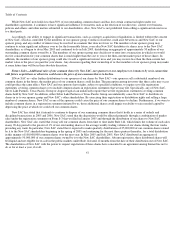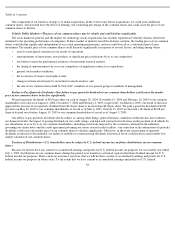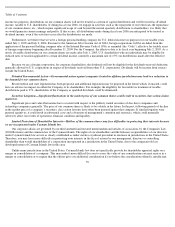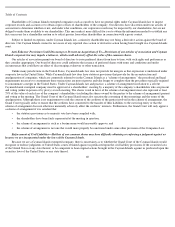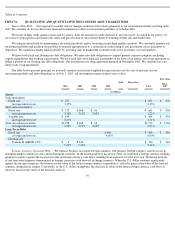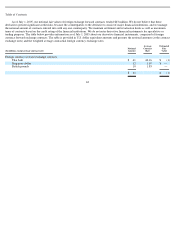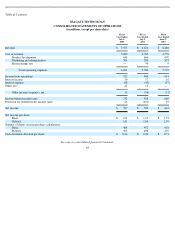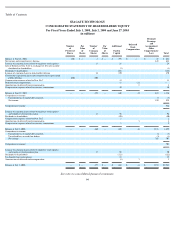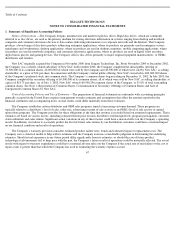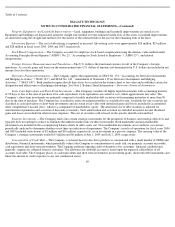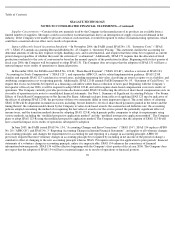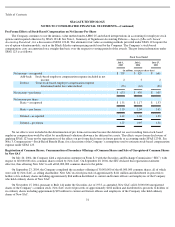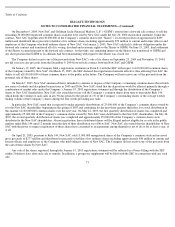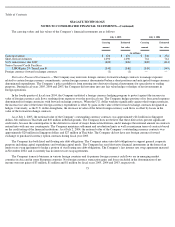Seagate 2004 Annual Report Download - page 70
Download and view the complete annual report
Please find page 70 of the 2004 Seagate annual report below. You can navigate through the pages in the report by either clicking on the pages listed below, or by using the keyword search tool below to find specific information within the annual report.
Table of Contents
SEAGATE TECHNOLOGY
NOTES TO CONSOLIDATED FINANCIAL STATEMENTS
1. Summary of Significant Accounting Policies
Nature of Operations —The Company designs, manufactures and markets rigid disc drives. Rigid disc drives, which are commonly
referred to as disc drives, are used as the primary medium for storing electronic information in systems ranging from desktop and notebook
computers and consumer electronics devices to data centers delivering information over corporate networks and the Internet. The Company
produces a broad range of disc drive products addressing enterprise applications, where its products are primarily used in enterprise servers,
mainframes and workstations; desktop applications, where its products are used in desktop computers; mobile computing applications, where
its products are used in notebook computers; and consumer electronics applications, where its products are used in digital video recorders,
digital music players and gaming devices. The Company sells its disc drives primarily to major original equipment manufacturers, or OEMs,
distributors and retailers.
New SAC originally acquired the Company in November 2000 from Seagate Technology, Inc. From November 2000 to December 2002,
the Company was a wholly-owned subsidiary of New SAC. In December 2002, the Company completed the initial public offering of
72,500,000 of its common shares, 24,000,000 of which were sold by the Company and 48,500,000 of which were sold by New SAC, as selling
shareholder, at a price of $12 per share. In connection with the Company’s initial public offering, New SAC converted its 400,000,000 shares
of the Company’s preferred stock, into common stock. The Company’s common shares began trading on December 11, 2002. In July 2003, the
Company completed the secondary offering of 69,000,000 of its common shares, all of which were sold by New SAC, as selling shareholder, at
a price of $18.75 per share. As of July 1, 2005, New SAC owned 169,500,246 common shares of the Company, or 35.6% of total outstanding
common shares. See Note 1, Registration of Common Shares, Consummation of Secondary Offerings of Common Shares and Sale of
Unregistered Common Shares by New SAC.
Critical Accounting Policies and Use of Estimates —The preparation of financial statements in conformity with accounting principles
generally accepted in the United States requires management to make estimates and assumptions that affect the amounts reported in the
financial statements and accompanying notes. Actual results could differ materially from those estimates.
The Company establishes certain distributor and OEM sales programs aimed at increasing customer demand. These programs are
typically related to a distributor’s level of sales, order size, advertising or point of sale activity or an OEM’s level of sale activity or agreed
upon rebate programs. The Company provides for these obligations at the time that revenue is recorded based on estimated requirements. These
estimates are based on various factors, including estimated future price erosion, distributor sell-through levels, program participation, customer
claim submittals and sales returns. Significant actual variations in any of these factors could have a material effect on the Company’s operating
results. In addition, our failure to accurately predict the level of future sales returns by our distribution customers could have a material impact
on our financial condition and results of operations.
The Company’s warranty provision considers estimated product failure rates, trends and estimated repair or replacement costs. The
Company uses a statistical model to help with its estimates and the Company exercises considerable judgment in determining the underlying
estimates. Should actual experience in any future period differ significantly from its estimates, or should the rate of future product
technological advancements fail to keep pace with the past, the Company’s future results of operations could be materially affected. The actual
results with regard to warranty expenditures could have a material adverse effect on the Company if the actual rate of unit failure or the cost to
repair a unit is greater than that which the Company has used in estimating the warranty expense accrual.
67


